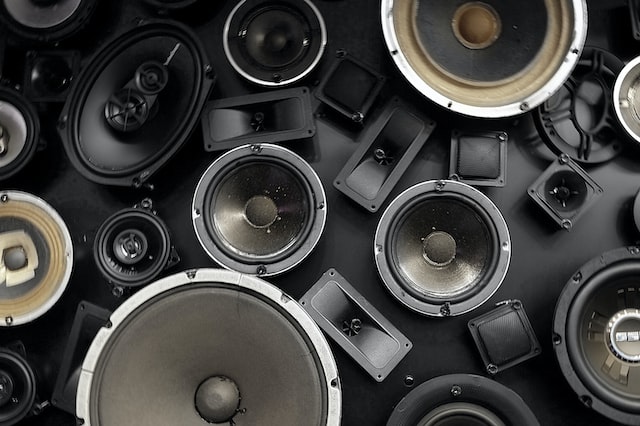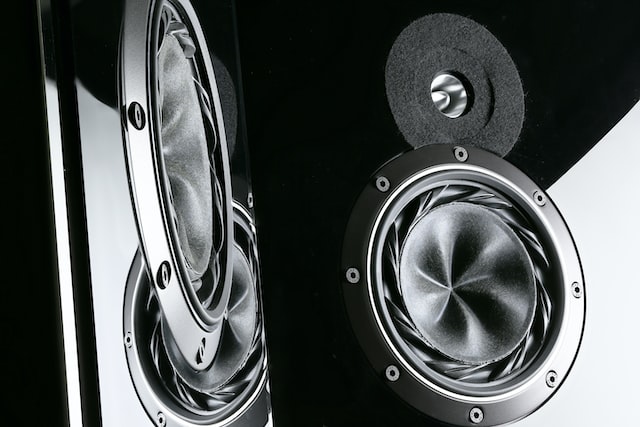AudioReputation is reader-supported. When you buy through links on our site, we may earn an affiliate commission Learn More

If you’re in the market for upgrading your car’s audio, you’ve certainly come across the two most popular types of speakers: component and coaxial.
That might have left you wondering which one is better for you. To answer this question, a few factors come into play, such as budget, preferences, and, most importantly, what your expectations are regarding upgrading your car’s audio system.
Today, we will explain all of the differences between component and coaxial speakers, what you can expect from them, and help you find the best option for your particular use case. Let’s get into the article!
Table of Contents
Component vs. Coaxial Speaker: What’s the Difference between Them?
Component speakers are designed for custom setups and can be mixed and matched, while coaxial speakers are an all-in-one solution, usually featuring at least a woofer and a tweeter in the same enclosure.
To understand the difference between component and coaxial speakers, we must understand how speakers work in the first place.
Let’s take, for example, a 3-way speaker setup consisting of a subwoofer, a mid-range woofer, and a tweeter. These will be responsible for reproducing low, mid, and high frequencies, respectively.
In a component speaker setup, all 3 drivers will be built in separate enclosures, and you can mix and match them or buy them in a kit.
In a coaxial speaker, all 3 drivers will be built in the same enclosure, and we can have it as an all-in-one solution since it is more convenient than component speakers.
These are not the only differences between component and coaxial speakers, so let’s dive into detail on how these two work.
Example of a component speaker kit from JBL.
What Are Component Speakers?
Component speakers are the preferred solution for audiophiles and audio enthusiasts. This type of speaker offers the best sound quality and customizing options.
In a component speaker setup, you have each driver built into a separate enclosure. For that reason, you can customize your setup however you like, and you have more freedom to plan the layout of your audio setup.
For example, you can try different placing options for the subwoofer in your car to see which you prefer.
Component speakers need a few extra pieces of equipment to function properly as well. To connect the speakers on your audio setup together, you need an external amplifier and a crossover.
The external amplifier will be responsible for feeding the speakers with the right amount of power, while the crossover is a device that separates the audio signal into different parts of the frequency spectrum to feed them to the right drivers.
In a typical 3-way component speaker system, you have a subwoofer, a woofer, and a tweeter. Respectively, these speakers will reproduce the low, low-mid, and mid-high frequencies on the spectrum.
Component speakers are usually more expensive and require more work on the installation process, but you can find a lot of ready-made kits on the market that makes installation much easier.
What Do They Offer?
Component speakers offer the best audio quality. Since you can choose each driver independently, audiophiles have more control over the components used on each part and how they will perform in a particular setup.
Component speakers also offer the most customizing options. You can plan your audio setup however you like: with a subwoofer, two or three woofers, multiple tweeters, etc. You get to decide, depending on how you want your system to perform.
Advantages of Component Speakers
- Component speakers allow you to customize everything in your audio setup, from your speaker drivers to the external amplifier and crossover.
- Similarly, you have more placement options when using component speakers.
- Despite being more expensive than their coaxial counterparts, most component speakers have superior sound quality and durability.
- If one of the drivers in your component speaker setup breaks, replacing them will be much easier than a coaxial speaker setup.
Disadvantages of Component Speakers
- Component speakers are more expensive than their coaxial counterparts.
- Component speakers require a more complex installation process and choosing each piece separately might be overwhelming for beginners.
A pair of coaxial speakers from Kenwood.
What Are Coaxial Speakers?
Coaxial speakers are the most common type of speakers you will find on the market. These devices feature all of the drivers built inside the same enclosure as well as a built-in crossover.
In a 2-way coaxial speaker, for example, you will usually find a woofer cone and a tweeter.
However, you can find coaxial speakers in virtually any configuration on the market, including 3-way, 4-way, and 5-way designs.
Most coaxial speakers’ design is also made to fit inside most car models’ stock mounts.
The biggest advantage of a pair of coaxial speakers is that they are much easier to install and are a hassle-free solution for most listeners. You can simply connect the speakers to your main head unit and enjoy your music.
Coaxial speakers will certainly please most casual music listeners, despite most not offering the same customization options, audio performance, and clarity found on their component counterparts.
While coaxial speakers are inferior to component ones when talking about audiophile-grade sound, they are superior to the stock speakers found on most car models, being a great option for an easy upgrade.
What Do They Offer?
Coaxial speakers offer a hassle-free solution to upgrade your car audio setup. They are very affordable, with prices starting as low as $25 for a pair. These make an excellent choice for those who are buying their first set of aftermarket speakers and don’t know what to expect yet.
The installation process of most coaxial speakers is also very simple. These devices should be directly connected to the head unit and won’t need an external amplifier or crossover to function properly.
Advantages of Coaxial Speakers
- Coaxial speakers are the most affordable solution, and you can easily find a pair for as low as $25.
- The installation process of coaxial speakers is very simple, and this type of speaker design doesn’t require an external amplifier or crossover to function properly.
- Coaxial speakers will fit into most stock car speaker mountings without the need for any alteration or adapter.
- Coaxial speakers are available in a lot of different designs with different configurations.
Disadvantages of Coaxial Speakers
- Coaxial speakers have an inferior sound if compared to their component counterparts, especially the budget models, since these products don’t have the best components.
- Coaxial speakers don’t offer the same amount of customization possibilities as component ones.
What Are the Differences between Component and Coaxial Speakers?
Now, let’s compare some of the main differences between component and coaxial speakers. These include design, speaker assembly and cost, installation process, and additional components.

1. Design
Perhaps the biggest difference between component and coaxial speakers is their design.
As we mentioned, a component speaker setup will have each driver built into different enclosures. For example, the subwoofer, woofer, and tweeter will all be separate.
In the case of coaxial speakers, all of the drivers and the built-in crossover are built inside the same enclosure, making the design more compact and easier to install.
There is also the fact that most coaxial speakers are made with the intention of fitting in the stock speaker mountings found in most car models and won’t require any alteration or adapters in the installation process.
Component speakers, on the other hand, may not fit every stock speaker mounting, so you need to measure your car and plan the layout of your audio setup beforehand.
2. Customization Options vs Convenience
Given their design, component speakers offer more customization options. You can choose which components you would like to include in your setup and buy more pieces separately later if you wish so.
A coaxial speaker audio setup won’t be as easily modifiable, but you get the benefit of the convenience that these devices offer.
This factor is an important one to consider, and you must think about the long run to decide whether it is best to invest in a component or coaxial pair of speakers.
3. Speaker Assembly and Components
As we mentioned in this article, what you find inside a component versus a coaxial speaker will vary drastically, despite having similar construction.
The pieces inside a component speaker usually have better quality than their coaxial counterparts. This can make quite a big difference in how the device performs, as most models are made with audiophile-grade sound in mind.
On a coaxial speaker, every component is built inside the same enclosure and the crossover is internal, which can lead to a bit of interference from one frequency to another in certain cases.
4. Installation Process and Additional Components
One of the main differences between component and coaxial speakers lies in their installation process and what you will need for each type of device to function properly.
The steps when installing a component speaker are more complex when compared to its coaxial counterparts. These devices require a defined layout before you get to work.
Additionally, component speakers will require an external amplifier and a crossover to work properly. These have the job, respectively, of powering and dividing the audio signal to send each frequency to its corresponding driver.
Coaxial speakers, on the other hand, don’t require much work to be installed. If they are compatible with your car model specifications, they just need to be mounted and connected to your main head unit.
5. Price
A large difference between component and coaxial speaker setups that we must talk about is their price. Depending on your budget, one option might be better than the other.
Component speakers tend to run for a higher price, but that will vary greatly as well since there are a lot of options on the market. You can find a basic component kit, including two woofers and a tweeter, for around $40, but this value can go up to a few hundred dollars, depending on your choice.
The market for coaxial speakers offers a large variety as well, so there are options for every budget, but a simple pair of 2-way coaxial speakers can be bought for as low as $20.
Another moment where price will come into play is in the installation process for these two types of speakers. Installing a component setup takes a bit more time and might require modifications to your car’s stock speaker mountings, so the labor cost is higher.
As we said, coaxial speakers can be installed at home if you have the necessary experience, but we recommend that most customers leave this job for a specialized car shop, where the installation cost won’t be that high if compared to a component speaker kit.
6. Speaker Layout
The layout for your audio setup will differ because on a component speaker setup, you have each driver built on a separate enclosure, as opposed to a coaxial one where they are found within the same casing.
On a component speaker setup, you must plan the layout carefully and research which is the best way to arrange each driver in your car. A common layout is having the woofer and the tweeters in the front and a subwoofer in the back.
Coaxial speakers won’t require much planning since most car models nowadays feature at least two to four stock speaker mounting holes. You can simply replace your stock speakers with your newly bought ones, given they have the same size.
7. Power Rating
In the world of car speakers, power rating refers to how much power a speaker can handle before distorting or burning out.
Whether you choose a component or a coaxial speaker for your car, it is important to attend to this specification and make sure it is compatible with your external amplifier or head unit.
As for the differences in power ratings between component and coaxial speakers, the former tends to have a higher power rating when compared to the latter. That means the component speakers are able to handle higher bursts of power before distorting.
This factor can impact the quality of your audio, especially if you like listening to music at loud volumes.
The power rating will vary greatly depending on the particular model of speaker you choose, so make sure you check the specifications of the particular product you have your eye on before making a purchase.
Check our guide on Coaxial Speaker Cable
FAQs
Yes, coaxial speakers usually feature at least a woofer and a tweeter. With that in mind, they are designed so that each speaker provides a full-range sound that covers all of the frequency spectra.
A coaxial connection can deliver better audio quality than an optical one, so it, in fact, tends to sound better, especially when we’re talking about car audio systems.
In short, yes. A digital coaxial connection has better quality audio than RCA and better shielding capabilities, but the best connection type will depend on the situation.
Conclusion
After reviewing the pros and cons of each speaker type, we can conclude a few things.
While component speakers provide the best audio quality and customization options, it comes with the expense of having a more complex installation process and costing more money.
Coaxial speakers are inexpensive, easy to install, and don’t require as much caution when planning your audio setup, but they are inferior when it comes to sound quality.
We recommend a component speaker setup if you’re an experienced user and want the best possible sound for your car.
For most people, though, a coaxial speaker setup will be more than sufficient for casual music listening and is a much more convenient option.
Whichever you choose, research extensively and consider extra factors such as installation and labor costs before purchasing the product.
We hope this article was helpful. If you have any questions or would like to discuss further about the article, feel free to contact us!

Hello, I’m Ian.
I’m a music producer, musician, and writer for the AudioReputation website. I’ve been involved with making music and the processes revolving around audio technology for longer than I can recall, so I find it amusing to share my knowledge with fellow enthusiasts worldwide when I’m not working with artists or creating new songs.
Along my path as a music maker, I discovered the ability to write informative content, and I decided to embrace it. I’ve written for a few websites about audio and music, including a digital magazine.
I’m particularly passionate about any sort of audio gear: guitar pedals, amplifiers, headphones, and even home speakers. That makes it really joyful for me to review any product related to the subject and give my honest opinion about them. I also frequently write tips and guides for consumer and professional-grade audio.


